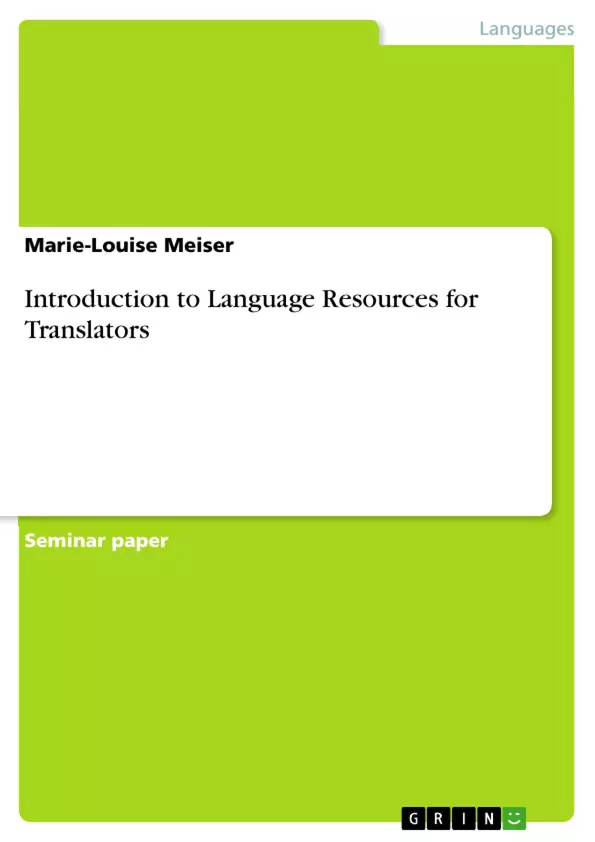This work is about different corpora and translation tools, which can assist during the translation process and have been used in order to ensure a high level of translation quality.
In this paper, different exercises with the aforementioned corpora and tools have been carried out.
The term “corpus” can be defined as a collection of spoken or written utterances that exist in machine-readable form (annotated corpora) or in their “raw” state (unannotated corpora) and that are used for linguistic-related tasks. However, the term is mainly used to refer to machine-readable variety.
Corpora are used to analyze lexical, syntactic and semantic/pragmatic aspects, as well as comparing different languages and language registers to each other. The observations in these areas found through corpora cannot only be a support in translation, they can also bring clarity in areas such as historical linguistics and language acquisition.
In order to be applicable in those fields, the corpus must be multifunctional and reusable. Therefore, it needs to conform to standards of falsifiability (the model can be tested on different samples of corpus material and can be replaced by a better fitting model if necessary), completeness (the model has to account for unrestricted data), and objectivity (the model can objectively be tested by observers who do not have an emotional connection to its success or failure).
Inhaltsverzeichnis (Table of Contents)
- Introduction
- Exercise 1: Corpora: Definition, Corpus Parts, Kinds of Corpora and their Usage
- Definition
- Corpus Parts
- Kinds of Corpora
- Usage of Corpora
- Exercise 2: AntConc: Frequ. List, Keyword List, Coll., N-grams/Clusters, Con. Plot
- Frequency List
- Keyword List
- Collocational Behaviour
- Comparison between Collocates and Clusters/N-Grams
- Concordance Plot
- Exercise 3: Using TreeTagger for Annot., Analy. Annot. Errors, Analy. the Tagset
- Exercise 4: Creating an XML File, Def. Tags for Metad., Def. some new Tags
- Exercise 5: Search in BNC, Usage of Semantically Related Words, Using DWDS
- Search in BNC
- Usage of Semantically Related Words
- Using DWDS
- Exercise 6: Analyzing German Support Verb Constructions with CQPWeb
- Exercise 8: Passives in English and German and Translational Universals
- Translational Differences of English and German Passives
- Translational Universals: Shining Through and Normalization
- Exercise 9: Synonyms and Antonyms
- Exercise 10: Terminology Database MultiTerm
Zielsetzung und Themenschwerpunkte (Objectives and Key Themes)
The seminar „Ausgewählte Themen der Maschinellen Übersetzung und der Fachkommunikation: Introduction to Language Resources for Translators\" aims to provide a practical introduction to corpora and translation tools, focusing on their application in enhancing translational quality. The exercises presented throughout this text exemplify the use of various resources in exploring and understanding different aspects of language and translation.
- The definition and types of corpora
- Corpus analysis methods and tools, such as AntConc
- Language processing techniques like tagging and annotation
- Exploring translation universals and their impact on translation
- The application of specialized resources, such as terminology databases
Zusammenfassung der Kapitel (Chapter Summaries)
The seminar begins by introducing the concept of corpora and their different types, including monolingual, parallel, and comparable corpora. Exercise 1 delves into the definition, parts, and usage of corpora, highlighting their significance in linguistic analysis and translation. Exercise 2 explores the functionalities of AntConc, a corpus analysis tool, and its application in tasks such as frequency list analysis, keyword extraction, and collocation studies.
Moving on, Exercise 3 focuses on using TreeTagger for annotation and analysis of text corpora, while Exercise 4 delves into the creation of XML files and tag definition for metadata. Exercise 5 examines the British National Corpus (BNC), exploring the usage of semantically related words and the application of the DWDS (Digitales Wörterbuch der deutschen Sprache) resource. Exercise 6 delves into the analysis of German support verb constructions using CQPWeb.
Finally, Exercise 8 explores the topic of passives in English and German, highlighting translational differences and universals. These exercises showcase the diverse ways in which corpus linguistics and translation tools contribute to understanding language and facilitating the translation process.
Schlüsselwörter (Keywords)
The main keywords and focus topics of the text include corpora, translation tools, AntConc, TreeTagger, BNC, DWDS, CQPWeb, language resources, translation universals, linguistic analysis, and translation quality. These terms represent the core concepts and tools explored throughout the exercises, highlighting the importance of language resources in enhancing translation practice.
- Quote paper
- Marie-Louise Meiser (Author), 2017, Introduction to Language Resources for Translators, Munich, GRIN Verlag, https://www.grin.com/document/1187657



